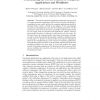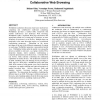164 search results - page 9 / 33 » On the Incoherencies in Web Browser Access Control Policies |
DBSEC
2006
13 years 8 months ago
2006
The need for enterprise application integration projects leads to complex composite applications. For the sake of security and efficiency, consolidated access control policies for ...
CSCW
2000
ACM
13 years 11 months ago
2000
ACM
WebSplitter symbolizes the union of pervasive multi-device computing and collaborative multi-user computing. WebSplitter provides a unified XML framework that enables multi-device...
EUROSYS
2010
ACM
14 years 14 days ago
2010
ACM
A complex software system typically has a large number of objects in the memory, holding references to each other to implement an object model. Deciding when the objects should be...
CSSE
2004
IEEE
13 years 7 months ago
2004
IEEE
One of the most important features of XML-based Web services is that they can be easily accessed over the Internet, but this makes them vulnerable to a series of security threats....
ACSAC
2009
IEEE
14 years 2 months ago
2009
IEEE
JavaScript-based browser extensions (JSEs) enhance the core functionality of web browsers by improving their look and feel, and are widely available for commodity browsers. To ena...


